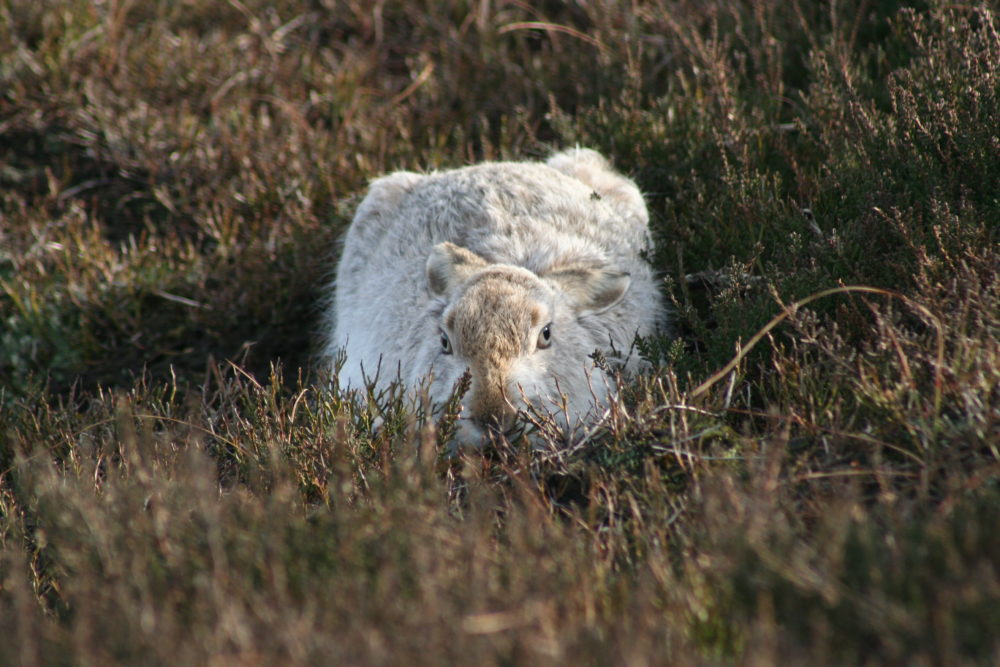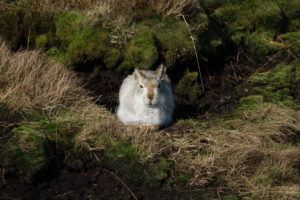Mountain hares in the Peak District

Status
Under threat in England.
Population
Under threat in Europe. One sole English population left, in the Peak District.
Scientific name
Lepus timidus
This project has now finished
Although mountain hares are still found in Ireland and parts of Scotland, they were virtually wiped out in England. However in the late 1800’s, small groups of mountain hares were reintroduced to the Peak District, Derbyshire and Yorkshire. Other attempts to translocate mountain hares to North Wales, the Lake District and Northumberland ultimately failed. Yet those released into the Peak District survived.
Mountain hares are our only true native hare – brown hares arrived with the Romans.
However, they now face very modern threats including human-caused pressures and climate change.
We have been supporting a four year study by Manchester Metropolitan University (MMU), gauging the conservation status of these hares. It is a major priority to understand how these hares have survived and how much longer they can go on for. This knowledge will be used to guide successful reintroductions as well as safeguarding those mountain hares left. These animals play an important role in the ecosystem and provide pleasure for tourists as icons of moorland landscapes.
The problem
The Peak District mountain hares are recognised as beautiful almost-exotic creatures, noticeable for their winter white fur contrasting against the dusky browns of the uplands. In the Peak District, they exist in an isolated vulnerable population, living upon rough, exposed moors, with no potential for inward migration of other hares.
Direct threats to mountain hares include heavy traffic on several major trunk roads, hunting and persecution.
The impact of changing land use practices upon them are not yet known, and some historic sub-populations have become locally extinct.
There are further subtle and dangerous pressures for the mountain hares. Climate change can bring hotter summers, increasing fire risk; wetter autumns can create feeding and shelter challenges for young leverets; severe winters can bring about a thaw-freeze, where a layer of snow can freeze solid, making it difficult for a hare to dig through to find food.
With the Peak District mountain hares being effectively an “island population”, there may be risks of genetic depression, as the busy road system that bisect the moors may act as a barrier to dispersal and small scale gene flow. Elsewhere, recent investigations of other groups of mountain hares and the similar Irish hare have identified a further threat to the species; the European brown hare. It resides in neighbouring terrain and can replace mountain hare populations through competition or hybridisation.
The solution
We are establishing an in-depth study, led by Carlos Bedson at MMU, to understand the sustainability of the present group of mountain hares in the Peak District. It is hard to estimate the numbers of hares, as they tend to lie low under deep vegetation. As a result of this we are assembling a new, novel combination of techniques, including line transect observational surveys, deployment of remote cameras and a drone camera. These methods also provide a good opportunity to evaluate hare and habitat associations and the effects of human infrastructure.
 Genetic material will be obtained either from material such as dung samples or carcasses.
Genetic material will be obtained either from material such as dung samples or carcasses.
These data will then be used to construct demographic models (including for example hare hotspot maps) for investigating how the mountain hare population may respond to changes in land-use, levels of persecution, interaction with brown hares, and different climate change scenarios within the Park.
The results of Carlos’ studies will help to provide advice crucial to saving our last wild mountain hares, and identify the most important population parameters to be prioritised for future hare re-introductions.
Progress so far
With your donations, working with Manchester Metropolitan University, we have already:
- Identified the most practical ways to survey for mountain hares, which are adept at hiding by day, only coming out a night.
- Determined the absolute number of mountain hares which persist on the moors: far fewer than previously thought.
- Used citizen science data from the last 10 years, to map the distribution of mountain hares and explain the environmental, habitat and land use factors which are conducive or detrimental to their survival.
- Developed models which describe how mountain hares are forecast to suffer large range reductions, arising from climate change and competitive exclusion by brown hares.
These findings are being prepared for publication within the science community and will form part of the conservation evidence that informs policies and protections for these vulnerable animals.
We still need to examine other factors which may particularly affect the viability of the mountain hare in the Peak District. We are currently planning to:
- Collect genetic material from carcasses to allow us to understand the extent to which these mountain hares, isolated from all others, may be inbred.
- Monitor all causes of mortality: natural, roadkill and from human pressures. In particular the roadkill figures for mountain hares in the Peak District are some of the worst reported for any mammal in the UK.
- Create a population viability model which will establish the sensitivity of the mountain hares to all threats, predict their extinction risk and provide recommendations for their preservation.
Thank you to everyone who donated to help protect these bats and their roost. Read the final story on this project:
